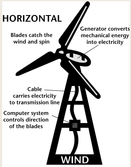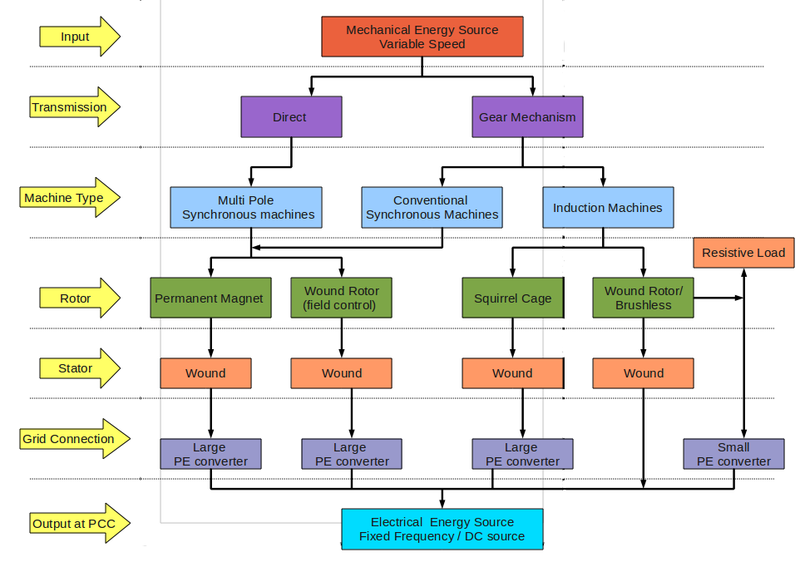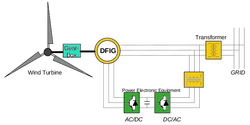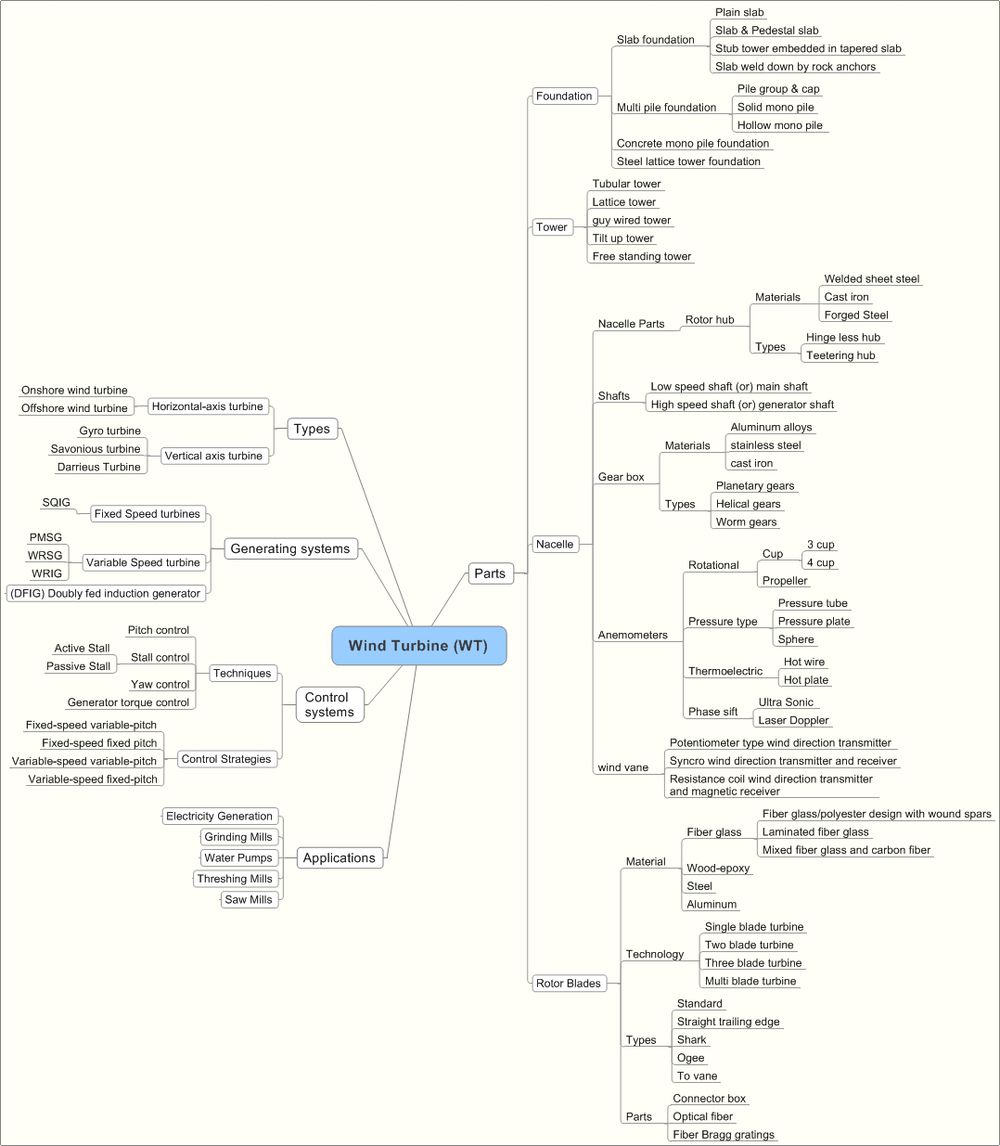Difference between revisions of "Wind Energy Background"
(→Brief History of Wind Energy) |
Abhinandanb (Talk | contribs) (→Brief History of Wind Energy) |
||
| (25 intermediate revisions by 2 users not shown) | |||
| Line 1: | Line 1: | ||
| − | |||
| − | |||
| − | |||
| − | |||
| − | |||
| − | |||
| − | |||
| − | |||
| − | |||
| − | |||
| − | |||
| − | |||
| − | |||
| − | |||
| − | |||
| − | |||
| − | |||
| − | |||
| − | |||
| − | |||
| − | |||
| − | |||
| − | |||
| − | |||
| − | |||
| − | |||
| − | |||
==Working Principle of Wind Turbine == | ==Working Principle of Wind Turbine == | ||
Wind is air in motion. It is a form of solar energy. Solar radiation heats every part of the Earth’s surface unevenly due to irregularities and rotation of earth. The flow of wind patterns are modified by the earth's terrain, bodies of water, and vegetative cover. When air moves, causing wind, it has kinetic energy. The kinetic energy of wind can be captured by a wind turbine and converted to other forms of energy such as electricity or mechanical power. | Wind is air in motion. It is a form of solar energy. Solar radiation heats every part of the Earth’s surface unevenly due to irregularities and rotation of earth. The flow of wind patterns are modified by the earth's terrain, bodies of water, and vegetative cover. When air moves, causing wind, it has kinetic energy. The kinetic energy of wind can be captured by a wind turbine and converted to other forms of energy such as electricity or mechanical power. | ||
| − | [[Image: | + | [[Image:windenergy windprinciple1.png|center|550px|thumb|Fig 3 '''[http://www.atlantissolar.com/wind_story.html Wind turbine principle]''']] |
Sources:[http://windeis.anl.gov/guide/basics/index.cfm Wind Energy Basics],[http://www1.eere.energy.gov/windandhydro/wind_how.html#inside How Wind Turbines Work] | Sources:[http://windeis.anl.gov/guide/basics/index.cfm Wind Energy Basics],[http://www1.eere.energy.gov/windandhydro/wind_how.html#inside How Wind Turbines Work] | ||
| Line 37: | Line 10: | ||
{|border="2" cellspacing="0" cellpadding="4" width="100%" | {|border="2" cellspacing="0" cellpadding="4" width="100%" | ||
| − | | align = "center" bgcolor = "# | + | | align = "center" bgcolor = "#4F81BD"|<font color="#FFFFFF">'''Horizontal axis wind turbines'''</font> |
| − | | align = "center" bgcolor = "# | + | | align = "center" bgcolor = "#4F81BD"|<font color="#FFFFFF">'''Vertical axis wind turbines'''</font> |
|- | |- | ||
| − | | | + | |bgcolor = "#DCE6F1"| |
| − | * It is mounted on top of a tower ,requires huge towers leads to complex in operation, | + | * It is mounted on top of a tower ,requires huge towers leads to complex in operation, maintenance and high initial costs. |
* It operates only with upstream or down stream wind directions. | * It operates only with upstream or down stream wind directions. | ||
| − | * It can be constructed in | + | * It can be constructed in off-shores. |
* It produces large amount of electricity with high efficiency. | * It produces large amount of electricity with high efficiency. | ||
| − | + | |bgcolor = "#DCE6F1"| | |
| − | | | + | |
* These are easy to build and maintain, safer, easier to transport and they can be mounted close to the ground. | * These are easy to build and maintain, safer, easier to transport and they can be mounted close to the ground. | ||
| − | * These can handle much | + | * These can handle much turbulence in wind than horizontal wind turbines. |
* Mostly it can be constructed with two blades | * Mostly it can be constructed with two blades | ||
* It operates with any direction of wind | * It operates with any direction of wind | ||
* Production of electricity is less due to low wind speeds near to ground | * Production of electricity is less due to low wind speeds near to ground | ||
| − | [[Image:vertical.jpg|center|thumb|Fig 4(b)[http://www.solarpowerwindenergy.org/2009/12/25/types-of-wind-turbines/ Vertical axis wind turbine]]] | + | |- |
| + | |[[Image:Horizontal.jpg|center|thumb|Fig 4(a)'''[http://www.windturbinesnow.com/horizontalaxis-windturbines.htm Horizontal axis wind turbine]''']] | ||
| + | |[[Image:vertical.jpg|center|thumb|Fig 4(b)'''[http://www.solarpowerwindenergy.org/2009/12/25/types-of-wind-turbines/ Vertical axis wind turbine]''']] | ||
| + | |- | ||
|} | |} | ||
| Line 77: | Line 52: | ||
{|border="2" cellspacing="0" cellpadding="4" width="100%" | {|border="2" cellspacing="0" cellpadding="4" width="100%" | ||
| − | | align = "center" bgcolor = "# | + | | align = "center" bgcolor = "#4F81BD"| |
| − | | align = "center" bgcolor = "# | + | | align = "center" bgcolor = "#4F81BD"|<font color="#FFFFFF">'''Fixed speed generating systems'''</font> |
| − | | align = "center" bgcolor = "# | + | | align = "center" bgcolor = "#4F81BD"|<font color="#FFFFFF">'''Variable speed generating systems'''</font> |
| − | | align = "center" bgcolor = "# | + | | align = "center" bgcolor = "#4F81BD"|<font color="#FFFFFF">'''Doubly fed induction generator'''</font> |
|- | |- | ||
| Line 89: | Line 64: | ||
|- | |- | ||
| − | | Machines | + | |bgcolor = "#DCE6F1"| Machines |
| − | | SQIG | + | |bgcolor = "#DCE6F1"|SQIG |
| − | | PMSG/WRSG/WRIG | + | |bgcolor = "#DCE6F1"| PMSG/WRSG/WRIG |
| − | | DFIG | + | |bgcolor = "#DCE6F1"| DFIG |
|- | |- | ||
| Advantages | | Advantages | ||
| <nowiki>* Simple and low cost </nowiki> | | <nowiki>* Simple and low cost </nowiki> | ||
| − | <nowiki>* Low | + | <nowiki>* Low maintenance </nowiki> |
| <nowiki>* Complete control of real and reactive powers</nowiki> | | <nowiki>* Complete control of real and reactive powers</nowiki> | ||
| Line 108: | Line 83: | ||
|- | |- | ||
| − | | Drawbacks | + | |bgcolor = "#DCE6F1"| Drawbacks |
| − | | <nowiki>* </nowiki>No control on real and reactive power | + | |bgcolor = "#DCE6F1"| <nowiki>* </nowiki>No control on real and reactive power |
<nowiki>* Less optimum power extraction capability</nowiki> | <nowiki>* Less optimum power extraction capability</nowiki> | ||
| Line 116: | Line 91: | ||
<nowiki>* High mechanical stress on turbine mechanical components</nowiki> | <nowiki>* High mechanical stress on turbine mechanical components</nowiki> | ||
| − | | <nowiki>* Additional cost of power electronics</nowiki> | + | |bgcolor = "#DCE6F1"| <nowiki>* Additional cost of power electronics</nowiki> |
<nowiki>* Limited fault ride through capability</nowiki> | <nowiki>* Limited fault ride through capability</nowiki> | ||
| − | | <nowiki>* Regular maintenance of slip ring and gearbox</nowiki> | + | |bgcolor = "#DCE6F1"| <nowiki>* Regular maintenance of slip ring and gearbox</nowiki> |
<nowiki>* Limited fault ride-through capability</nowiki> | <nowiki>* Limited fault ride-through capability</nowiki> | ||
| Line 135: | Line 110: | ||
{|border="2" cellspacing="0" cellpadding="4" width="100%" | {|border="2" cellspacing="0" cellpadding="4" width="100%" | ||
| − | |align = "center" bgcolor = "# | + | |align = "center" bgcolor = "#4F81BD"|<font color="#FFFFFF">'''Control System'''</font> |
| − | |align = "center" bgcolor = "# | + | |align = "center" bgcolor = "#4F81BD"|<font color="#FFFFFF">'''Pitch contol'''</font> |
| − | |align = "center" bgcolor = "# | + | |align = "center" bgcolor = "#4F81BD"|<font color="#FFFFFF">'''Yaw control'''</font> |
| − | |align = "center" bgcolor = "# | + | |align = "center" bgcolor = "#4F81BD"|<font color="#FFFFFF">'''Stall control'''</font> |
| − | |align = "center" bgcolor = "# | + | |align = "center" bgcolor = "#4F81BD"|<font color="#FFFFFF">'''Generator torque control'''</font> |
|- | |- | ||
| − | |align = "center" bgcolor = "# | + | |rowspan="2" align = "center" bgcolor = "#DCE6F1"|'''Description''' |
| − | | A method of controlling the speed of a wind turbine by varying the orientation, or pitch, of the blades, and thereby altering its aerodynamics and efficiency. | + | |-valign="top' bgcolor = "#DCE6F1"|A method of controlling the speed of a wind turbine by varying the orientation, or pitch, of the blades, and thereby altering its aerodynamics and efficiency. |
| − | + | ||
Source:[http://www.moog.com/markets/energy/wind-turbines/blade-pitch-control/ Blade Pitch Control] | Source:[http://www.moog.com/markets/energy/wind-turbines/blade-pitch-control/ Blade Pitch Control] | ||
| − | | The rotation of horizontal axis wind turbine around its tower to orient the turbine in upwind or down wind direction. | + | |bgcolor = "#DCE6F1"|The rotation of horizontal axis wind turbine around its tower to orient the turbine in upwind or down wind direction. |
| − | + | ||
Source:[http://zone.ni.com/devzone/cda/tut/p/id/8189 Wind Turbine Control Methods] | Source:[http://zone.ni.com/devzone/cda/tut/p/id/8189 Wind Turbine Control Methods] | ||
| − | |Stall control works by increasing the angle at which the relative wind strikes the blades (angle of attack). As the wind speed increases drag force on the blade increase and lift force gets reduces, thus finally reduces the speed of turbine.A fully stalled turbine blade, when stopped, has the flat side of the blade facing directly into the wind. Compare with furling. | + | |bgcolor = "#DCE6F1"|Stall control works by increasing the angle at which the relative wind strikes the blades (angle of attack). As the wind speed increases drag force on the blade increase and lift force gets reduces, thus finally reduces the speed of turbine.A fully stalled turbine blade, when stopped, has the flat side of the blade facing directly into the wind. Compare with furling. |
Source:[http://www.windmeup.org/2008/03/stall-control-basics.html Stall-control basics] | Source:[http://www.windmeup.org/2008/03/stall-control-basics.html Stall-control basics] | ||
| − | |As the aerodynamic torque control changes, rotor speed changes. it changes the output power frequency. A frequency converter is connected in between generator and the network to maintain generator power constant. | + | |bgcolor = "#DCE6F1"|As the aerodynamic torque control changes, rotor speed changes. it changes the output power frequency. A frequency converter is connected in between generator and the network to maintain generator power constant. |
Source[[Media:windenergycontrol.pdf|Wind Energy Control]] | Source[[Media:windenergycontrol.pdf|Wind Energy Control]] | ||
| + | |- | ||
| + | |[[Image:pitch.jpg|thumb|center|175px|Fig 16(a) '''[http://zone.ni.com/devzone/cda/tut/p/id/8189 Pitch control]''']] | ||
| + | |[[Image:Yaw.jpg|thumb|center|175px|Fig 16(b) '''[http://zone.ni.com/devzone/cda/tut/p/id/8189 Yaw control]''']] | ||
| + | |align="center"| NA | ||
| + | |align="center"| NA | ||
|- | |- | ||
|} | |} | ||
| Line 164: | Line 142: | ||
A majority of patents describing wind turbines or wind energy are classified in the following IPC classifications. | A majority of patents describing wind turbines or wind energy are classified in the following IPC classifications. | ||
{|border="2" cellspacing="0" cellpadding="4" width="100%" | {|border="2" cellspacing="0" cellpadding="4" width="100%" | ||
| − | | align = "center" bgcolor = "# | + | | align = "center" bgcolor = "#4F81BD"|<font color="#FFFFFF">'''S.NO'''</font> |
| − | | align = "center" bgcolor = "# | + | | align = "center" bgcolor = "#4F81BD"|<font color="#FFFFFF">'''IPC Classification'''</font> |
| − | | align = "center" bgcolor = "# | + | | align = "center" bgcolor = "#4F81BD"|<font color="#FFFFFF">'''Description'''</font> |
|- | |- | ||
| − | | align = "center" bgcolor = "# | + | | align = "center" bgcolor = "#DCE6F1"|1 |
| − | | align = "center"|[http://www.wipo.int/ipcpub/#refresh=page¬ion=scheme&version=20110101&symbol=F03D F03D] | + | | align = "center" bgcolor = "#DCE6F1"|[http://www.wipo.int/ipcpub/#refresh=page¬ion=scheme&version=20110101&symbol=F03D F03D] |
| − | | | + | | bgcolor = "#DCE6F1"| Machines or engines for liquids; wind, spring, or weight motors; producing mechanical power or a reactive propulsive thrust / '''Wind motors''' |
|- | |- | ||
| − | | align = "center | + | | align = "center"|2 |
| align = "center"|[http://www.wipo.int/ipcpub/#refresh=page¬ion=scheme&version=20110101&symbol=F16C F16C] | | align = "center"|[http://www.wipo.int/ipcpub/#refresh=page¬ion=scheme&version=20110101&symbol=F16C F16C] | ||
| − | | | + | | Engineering elements or units; general measures for producing and maintaining effective functioning of machines or installations; thermal insulation in general/ '''Shafts; flexible shafts; elements of crankshaft mechanisms; rotary bodies other than gearing elements; bearings''' |
|- | |- | ||
| − | | align = "center" bgcolor = "# | + | | align = "center" bgcolor = "#DCE6F1"|3 |
| − | | align = "center"|[http://www.wipo.int/ipcpub/#refresh=page¬ion=scheme&version=20110101&symbol=F16H F16H] | + | | align = "center" bgcolor = "#DCE6F1"|[http://www.wipo.int/ipcpub/#refresh=page¬ion=scheme&version=20110101&symbol=F16H F16H] |
| − | | | + | | bgcolor = "#DCE6F1"| Engineering elements or units; general measures for producing and maintaining effective functioning of machines or installations; thermal insulation in general / '''Gearing''' |
|- | |- | ||
| − | | align = "center | + | | align = "center"|4 |
| align = "center"|[http://www.wipo.int/ipcpub/#refresh=page¬ion=scheme&version=20110101&symbol=F03B F03B] | | align = "center"|[http://www.wipo.int/ipcpub/#refresh=page¬ion=scheme&version=20110101&symbol=F03B F03B] | ||
| − | | | + | | Machines or engines for liquids; wind, spring, or weight motors; producing mechanical power or a reactive propulsive thrust / '''Machines or engines for liquids''' |
|- | |- | ||
| − | |align = "center" bgcolor = "# | + | | align = "center" bgcolor = "#DCE6F1"|5 |
| − | |align = "center"|[http://www.wipo.int/ipcpub/#refresh=symbol¬ion=scheme&version=20110101&symbol=H02K H02K] | + | | align = "center" bgcolor = "#DCE6F1"|[http://www.wipo.int/ipcpub/#refresh=symbol¬ion=scheme&version=20110101&symbol=H02K H02K] |
| − | | | + | | bgcolor = "#DCE6F1"|Generation, conversion, or distribution of electric power / '''Dynamo-electric machines''' |
|- | |- | ||
| − | | align = "center | + | | align = "center" |6 |
| align = "center"|[http://www.wipo.int/ipcpub/#&refresh=page¬ion=scheme&version=20110101&symbol=H02P H02P] | | align = "center"|[http://www.wipo.int/ipcpub/#&refresh=page¬ion=scheme&version=20110101&symbol=H02P H02P] | ||
| − | | | + | |Generation, conversion, or distribution of electric power / '''Control or regulation of electric motors, generators, or dynamo-electric converters; controlling transformers, reactors or choke coils''' |
|- | |- | ||
| − | | align = "center" bgcolor = "# | + | | align = "center" bgcolor = "#DCE6F1"|7 |
| − | | align = "center"|[http://www.wipo.int/ipcpub/#refresh=page¬ion=scheme&version=20110101&symbol=H02M H02M] | + | | align = "center" bgcolor = "#DCE6F1"|[http://www.wipo.int/ipcpub/#refresh=page¬ion=scheme&version=20110101&symbol=H02M H02M] |
| − | | | + | | bgcolor = "#DCE6F1"|Generation, conversion, or distribution of electric power / '''Apparatus for conversion between ac and ac, between ac and dc, or between dc and dc, and for use with mains or similar power supply systems; conversion of dc or ac input power into surge output power; control or regulation''' |
|- | |- | ||
| − | | align = "center | + | | align = "center"|8 |
| align = "center"|[http://www.wipo.int/ipcpub/#refresh=page¬ion=scheme&version=20110101&symbol=H02J H02J] | | align = "center"|[http://www.wipo.int/ipcpub/#refresh=page¬ion=scheme&version=20110101&symbol=H02J H02J] | ||
| − | | | + | | Generation, conversion, or distribution of electric power / '''Circuit arrangements or systems for supplying or distributing electric power; systems for storing electric energy''' |
|- | |- | ||
| − | | align = "center" bgcolor = "# | + | | align = "center" bgcolor = "#DCE6F1"|9 |
| − | | align = "center"|[http://www.wipo.int/ipcpub/#refresh=page¬ion=scheme&version=20110101&symbol=G06F G06F] | + | | align = "center" bgcolor = "#DCE6F1"|[http://www.wipo.int/ipcpub/#refresh=page¬ion=scheme&version=20110101&symbol=G06F G06F] |
| − | | | + | | bgcolor = "#DCE6F1"| Computing; calculating; counting /'''Electric digital data processing''' |
|- | |- | ||
| − | | align = "center | + | | align = "center" |10 |
| align = "center"|[http://www.wipo.int/ipcpub/#refresh=page¬ion=scheme&version=20110101&symbol=G05F G05F] | | align = "center"|[http://www.wipo.int/ipcpub/#refresh=page¬ion=scheme&version=20110101&symbol=G05F G05F] | ||
| − | | | + | | Controlling; regulating / '''Systems for regulating electric or magnetic variables''' |
|- | |- | ||
| − | | align = "center" bgcolor = "# | + | | align = "center" bgcolor = "#DCE6F1"|11 |
| − | | align = "center"|[http://www.wipo.int/ipcpub/#refresh=page¬ion=scheme&version=20110101&symbol=H02H H02H] | + | | align = "center" bgcolor = "#DCE6F1"|[http://www.wipo.int/ipcpub/#refresh=page¬ion=scheme&version=20110101&symbol=H02H H02H] |
| − | | | + | | bgcolor = "#DCE6F1"| Generation, conversion, or distribution of electric power / '''Emergency protective circuit arrangements''' |
|} | |} | ||
| Line 236: | Line 214: | ||
|} | |} | ||
<br> | <br> | ||
| + | |||
| + | <br> | ||
| + | |||
| + | |||
| + | {|border="2" cellspacing="0" cellpadding="1" width="15%" | ||
| + | | style="background-color:#999990;padding:0.079cm;"| <center>[http://dolcera.com/wiki/index.php?title=Wind_Energy <<Back to main page]</center> | ||
| + | |} | ||
Latest revision as of 21:01, 10 May 2011
Contents
Working Principle of Wind Turbine
Wind is air in motion. It is a form of solar energy. Solar radiation heats every part of the Earth’s surface unevenly due to irregularities and rotation of earth. The flow of wind patterns are modified by the earth's terrain, bodies of water, and vegetative cover. When air moves, causing wind, it has kinetic energy. The kinetic energy of wind can be captured by a wind turbine and converted to other forms of energy such as electricity or mechanical power.

Sources:Wind Energy Basics,How Wind Turbines Work
Horizontal Axis and Vertical Axis Wind Turbines
Wind turbines are mainly classified into two types based on the axis in which turbine rotates. They are Horizontal axis wind turbine(HAWT) and vertical axis wind turbine (VAWT). The table below presented, describes the advantages and disadvantages of HAWT's and VAWT's.
| Horizontal axis wind turbines | Vertical axis wind turbines |
|
|
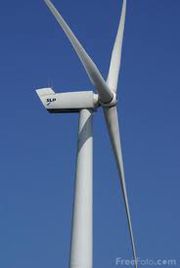 Fig 4(a)Horizontal axis wind turbine |
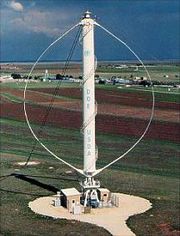 Fig 4(b)Vertical axis wind turbine |
Source:Different types of wind turbines
Horizontal Axis Wind Turbines
All grid-connected commercial wind turbines today are built with a horizontal axis type rotor which is installed on top of a tower. Most horizontal axis turbines built today are two- or three-bladed, although some have fewer or more blades. The purpose of the rotor is to convert the linear motion of the wind into rotational energy that can be used to drive a generator. Most of the systems have a gearbox, which turns the slow rotation of the blades into a quicker rotation that is more suitable to drive an electrical generator.
Click on the link below to see detailed description about horizontal axis wind turbines.
Different Types and Parts of a Horizontal Axis Wind Turbines
Electrical Generating Systems
The various types of electrical generating systems used in wind energy systems are shown in figure.
Source:Wind Turbine Generators
The most commonly used generator systems applied in wind turbines are are explained below.
| Fixed speed generating systems | Variable speed generating systems | Doubly fed induction generator | |
| Structure | |||
| Machines | SQIG | PMSG/WRSG/WRIG | DFIG |
| Advantages | * Simple and low cost
* Low maintenance |
* Complete control of real and reactive powers
* High energy efficiency |
* Reduced capacity converter
* Decoupled control of active and reactive power flow * Smooth grid connection |
| Drawbacks | * No control on real and reactive power
* Less optimum power extraction capability * Poor power factor * High mechanical stress on turbine mechanical components |
* Additional cost of power electronics
* Limited fault ride through capability |
* Regular maintenance of slip ring and gearbox
* Limited fault ride-through capability |
Source:Inside wind turbines
In this report, a comprehensive analysis of patent and non-patent literature is done with a focus on Doubly-fed induction generator systems.
Wind Turbine Control Systems
As the wind turbines increases in size and power, control systems plays a major role to operate wind turbines in safe region and also to improve efficiency and quality of power conversion. The main objectives of wind turbine control systems is
- Energy capture : Operating the wind turbine to extract maximum amount of energy considering safe restrictions like rated power, rated speed, cut-out wind speed etc.,
- Mechanical loads: protecting the systems from transient loads.
- Power quality: Conditioning the generated power with grid interconnection standards.
The various control techniques used in wind turbines are shown in table below
| Control System | Pitch contol | Yaw control | Stall control | Generator torque control |
| Description | ||||
| The rotation of horizontal axis wind turbine around its tower to orient the turbine in upwind or down wind direction.
Source:Wind Turbine Control Methods |
Stall control works by increasing the angle at which the relative wind strikes the blades (angle of attack). As the wind speed increases drag force on the blade increase and lift force gets reduces, thus finally reduces the speed of turbine.A fully stalled turbine blade, when stopped, has the flat side of the blade facing directly into the wind. Compare with furling.
Source:Stall-control basics |
As the aerodynamic torque control changes, rotor speed changes. it changes the output power frequency. A frequency converter is connected in between generator and the network to maintain generator power constant.
SourceWind Energy Control | ||
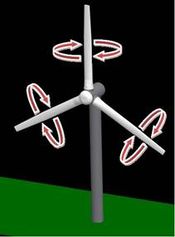 Fig 16(a) Pitch control |
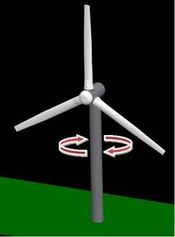 Fig 16(b) Yaw control |
NA | NA |
Taxonomy for Wind Turbines
A detailed taxonomy is presented which covers Parts, Types, Control Systems, Generating systems and Applications of wind turbines.
IPC Classifications
A majority of patents describing wind turbines or wind energy are classified in the following IPC classifications.
| S.NO | IPC Classification | Description |
| 1 | F03D | Machines or engines for liquids; wind, spring, or weight motors; producing mechanical power or a reactive propulsive thrust / Wind motors |
| 2 | F16C | Engineering elements or units; general measures for producing and maintaining effective functioning of machines or installations; thermal insulation in general/ Shafts; flexible shafts; elements of crankshaft mechanisms; rotary bodies other than gearing elements; bearings |
| 3 | F16H | Engineering elements or units; general measures for producing and maintaining effective functioning of machines or installations; thermal insulation in general / Gearing |
| 4 | F03B | Machines or engines for liquids; wind, spring, or weight motors; producing mechanical power or a reactive propulsive thrust / Machines or engines for liquids |
| 5 | H02K | Generation, conversion, or distribution of electric power / Dynamo-electric machines |
| 6 | H02P | Generation, conversion, or distribution of electric power / Control or regulation of electric motors, generators, or dynamo-electric converters; controlling transformers, reactors or choke coils |
| 7 | H02M | Generation, conversion, or distribution of electric power / Apparatus for conversion between ac and ac, between ac and dc, or between dc and dc, and for use with mains or similar power supply systems; conversion of dc or ac input power into surge output power; control or regulation |
| 8 | H02J | Generation, conversion, or distribution of electric power / Circuit arrangements or systems for supplying or distributing electric power; systems for storing electric energy |
| 9 | G06F | Computing; calculating; counting /Electric digital data processing |
| 10 | G05F | Controlling; regulating / Systems for regulating electric or magnetic variables |
| 11 | H02H | Generation, conversion, or distribution of electric power / Emergency protective circuit arrangements |
Major Players
Major players in the Wind Energy sector include: General Electric, Vestas Wind Systems, Siemens AG, Mitsubishi Ltd, REPower Systems AG, Gamesa Innovation & Technology, Enercon, Nordex, Suzlon and Sinovel Wind Group Co. Ltd.
Like this report?
This is only a sample report with brief analysis
Dolcera can provide a comprehensive report customized to your needs
| |
